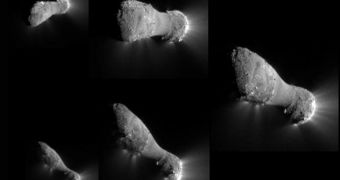When the Deep Impact spacecraft visited comet Hartley 2 late last year, it managed to catch a number of pictures showing the tremendous levels of activity going on on the small space body. The existence of that activity is currently perplexing scientists.
The NASA space probe caught up with Hartley 2 in November 2010, and imaged its target thoroughly before the two became separated. The fact that this comet is an active object surprised everyone.
According to astronomers, the first things that were observed about the comet included the fact that it rolls around its long axis, while at the same time spinning around its central axis, just like Earth does.
In addition, rocky spires were discovered on the surface, resembling spikes. The formations could reach a height of up to 70 meters (230 feet), investigators revealed at the 42nd Lunar and Planetary Science Conference. The meeting was held in The Woodlands, Texas.
A scientist at the University of Maryland explained attendants that Hartley 2 spews out a lot more water than any comet of its size discovered so far. The expert, astronomer Michael A'Hearn, was the principal investigators of the NASA flyby mission.
The main mechanism underlying this type of activity is the sublimation (turning from solid to gas) of frozen carbon dioxide located within the comet itself. As this happens, the gas builds up and is eventually jettisoned, but it also takes a lot of water and ice particles with it.
“There are at least a dozen other comets for which we know that they're relatively high in activity for nucleus size, and they're probably driven either by carbon dioxide or carbon monoxide,” A'Hearn said.
“What we don't know yet it whether these are a separate class or whether they're just a continuum extending from these more 'normal' comets,” the expert told Space.
He added that Deep Impact was able to snap about 125,000 images of the comet on November 4, 2010, as it flew about 700 kilometers (435 miles) above the object's surface.
“We've got an environment of material being moved around on the surface, a sedimentary environment in an object that is losing mass,” explains Peter Thomas, an expert at Cornell University.
The scientist, who is a geomorphologist, was in charge of analyzing the terrain Deep Impact revealed on Hartley 2. He adds that researchers also discovered the central areas of the comet to be more active in producing water than the ends.
At this point, it's still early to hypothesize about the mechanisms that led to the formation of this interesting body. “We hope to be able to do that within six months or so,” A'Hearn added.

 14 DAY TRIAL //
14 DAY TRIAL //